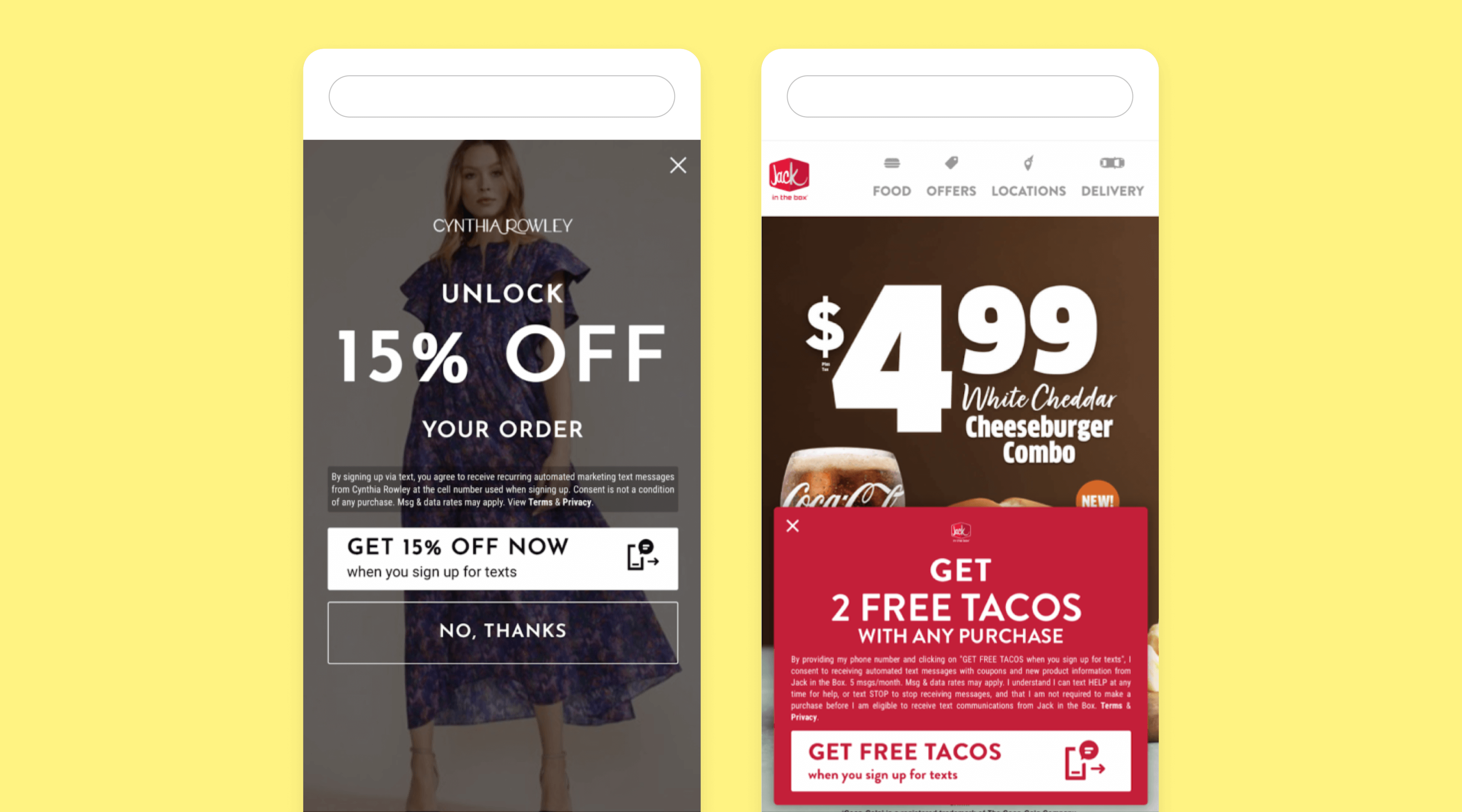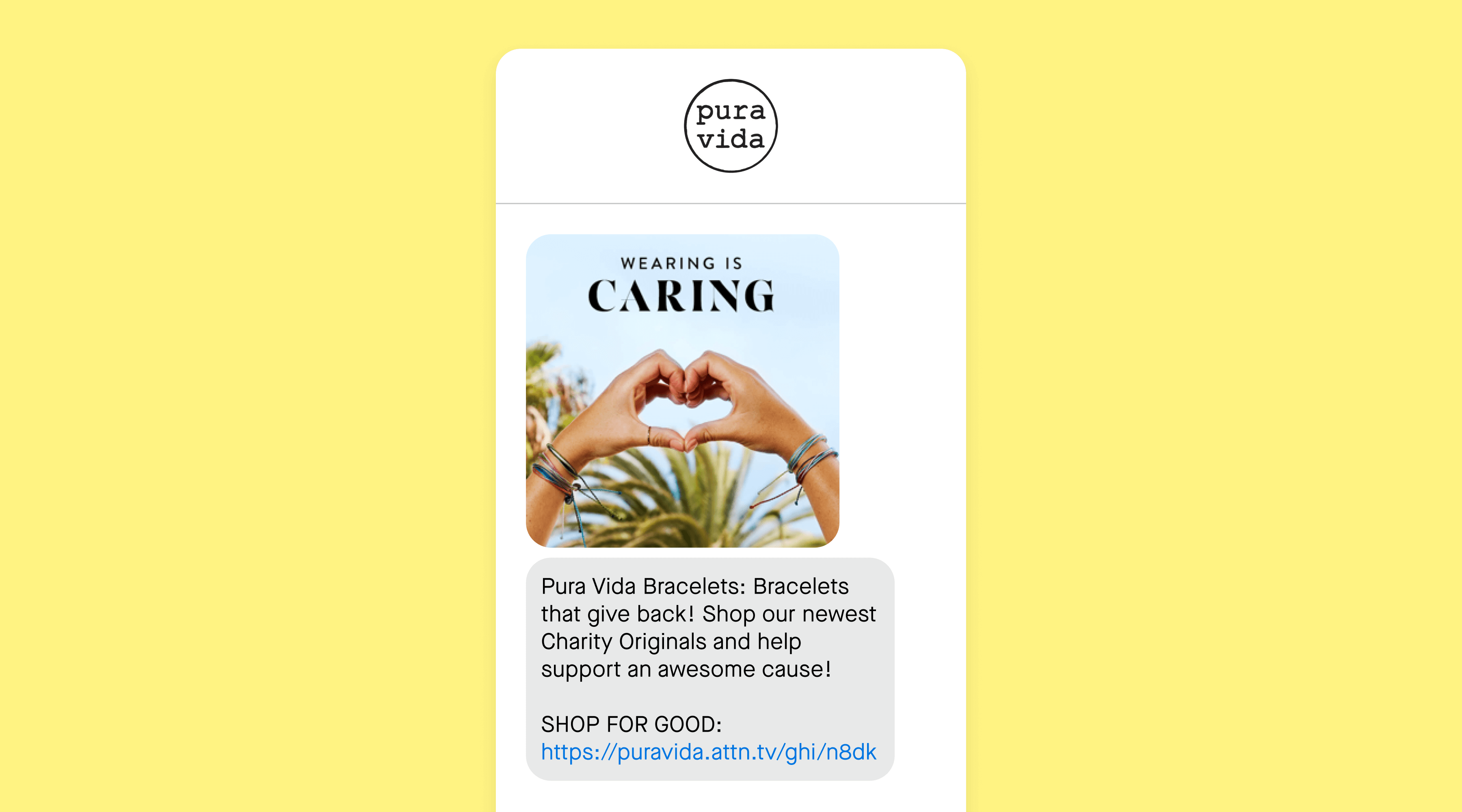
New releases
A smarter, simpler Attentive
Explore new features →
Explore new features →

More of a visual learner? Access the Generational Marketing Infographic.
Personalized text messaging is a powerful tool to engage consumers of all ages. But segmenting your audience by generation—and knowing their values, attitudes, and preferences—can take your SMS strategy to the next level.
With over 95% of Americans owning a mobile phone, text message marketing represents a significant revenue opportunity across generations. Get this:
Needless to say, text messaging can take a brand’s marketing efforts to new heights.
“When COVID-19 forced everyone indoors, we were spending more time than ever on our smartphones and in front of screens,” said Vince PeGan, VP of Sales, Mid Market, at Attentive. “Data from one of the big four cellular carriers tells us that there’s been a 26% increase in text messaging since the beginning of COVID. Additionally, we’ve seen a 53% increase in consumers signing up to receive text messages.”
Whether your brand is targeting Baby Boomers, Millennials, Gen Z, or all of the above, your target audience likely always has a mobile phone within reach, texts intermittently throughout the day, and is open to hearing from you via text message.
But that doesn’t mean a one-size-fits-all approach will work. There are still significant variations in what appeals to different generations, so it’s key to understand the differences in audiences to plan your strategies accordingly. Once you understand those differences, that’s where generational marketing comes into play.
If you asked a 20-year-old college student and a retired 70-year-old about their priorities and preferences for digital content, chances are you’ll get pretty different answers. Since they grew up in and were shaped by different eras, capturing their attention means segmenting them based on when they were born. Beyond that, it means offering content aligned with the attitudes and viewpoints of their respective eras. If you want to incorporate this strategy into your overall marketing plans, knowing what each generation values and how they interact with digital content is a great place to start.
Born 1946-1964
Boomers are drawn to brands that emphasize quality and value, and are interested in products that are durable and dependable. While they’re more likely to be influenced by traditional media than younger generations, Baby Boomers are just as likely to engage with brands via SMS. Data shows they engage in more branded text message interactions than any other group.
“Boomers are engaging in SMS in tremendous ways,” said Phillip Jackson, Chief Commerce Officer at RightPoint, a global experience company. “In fact, they’re early adopters in more branded interaction.”
While a straightforward text messaging sign-up process should always be prioritized, ease of use—and requiring as few steps as possible—is especially important for opting in older consumers who may not be as digitally savvy as their younger counterparts. Attentive’s “two-tap” sign-up enables consumers to tap a call to action button, which then loads a pre-populated text message on their phones, then the user simply hits send to begin receiving messages, creating an easy, seamless sign-up process for all ages.

While some Baby Boomers may prefer brick-and-mortar shopping over making purchases online, that doesn’t mean they’re out of reach for SMS marketers. Text-to-Join promotions allow brands to attract subscribers using in-store signage, kiosks, and physical mailers.
When it comes to the types of content Boomers want to receive: limited-time sales and discounts appeal to shoppers of all ages, but informational messages that provide key product details may be more valuable for older, more financially established generations purchasing big-ticket items. In fact, it’s reported that 6 out of 10 Boomers spend time reading blogs and online articles for information, and that 7 out of 10 enjoy watching product- and service-related videos. Regardless of the messaging—from product information to loyalty rewards program updates—personalization is key. Research indicates that the older the text message recipient is, the more the relevance of the message matters to them.
Born 1981-1996
While Millennial consumers are surely tired of being pigeonholed as a monolithic demographic, brands should pay attention to recurring themes among this generation. Many Millennials may fit a psychographic—a qualitative description of individuals’ characteristics and behaviors—known as HENRY, or “high earner, not rich yet.”
These are individuals who have disposable income and aren’t necessarily weighed down by the financial obligations of older generations, such as raising a family and owning a home. While they’re typically contending with other expenses—such as student loan payments—they’re comfortable handling everyday living costs and have money to spend on premium products and services.
HENRYs are experiential shoppers who seek social proof when choosing goods and brands. They’re digitally native and are keen to share their consumption choices with others. And, of course, they’re mobile-first consumers who are comfortable making purchases online.

If Millennials aren’t reading or sending a text, there’s a good chance they’re using their phones to log on to social media. More than 50% of Americans access social media platforms exclusively using mobile devices. And while 42% of Baby Boomers can go at least a week or more without checking their social feeds, the same percentage of Millennials can’t go more than five hours.
As the largest user base for Instagram, Millennials (and Gen Z) are often using it with shopping in mind—83% of people say Instagram helps them discover new products or services, and 54% of people made a purchase after seeing a product or service on Instagram. Attentive’s Instagram Stories sign-up feature—which allows followers to click the sticker on a brand’s Instagram Story and leads to a pre-populated text message to opt in—helps brands easily turn social audiences into text messaging subscribers. Cosmetics company Anastasia Beverly Hills used Attentive’s Instagram Stories sign-up feature in conjunction with website creatives to grow its SMS subscriber list by more than 250% in only nine months.
Social media provides brands a fast, affordable way to reach large audiences of often-times younger consumers. By combining this traffic with Attentive’s proven text message marketing tools, brands can transform social reach into revenue. For example, using advertisements on Snapchat, lifestyle accessory brand Dorsal Bracelets drove its social audience to its website, where consumers were greeted by an opt-in form offering a discount in return for signing up to receive emails and text messages from the brand.
As of July 2020, only seven months after launching its text message marketing program, sales attributed to text messages sent via Attentive accounted for 30% of Dorsal Bracelets’ total revenue.
In terms of the content that resonates best with Millennials, discounts and giveaways are often appealing—especially to younger generations with limited discretionary income. 86% percent of Millennials cite promotions or discounts as influential. While visual storytelling and interactive content are also important when marketing to this generation, consistent engagement is key. SMS provides a chance for brands to create deeper, more intimate 1:1 connections on a channel with an average open rate of 99%.
Demonstrating social proof via SMS is also a winning strategy. Content that highlights satisfied customers resonates with Millennials—who are more likely to trust online reviews as much as personal recommendations when compared to older generations. With this generation also likely to post reviews across digital channels, brands can tap into this trend by encouraging customers to write reviews via post-purchase text messages—helping turn subscribers into brand advocates.
Born 1997-Present
Gen Z, also referred to as Zoomers, lines up best with the CARLY psychographic, which stands for “can’t afford real life yet.”
“CARLYs are quite innovative—they’re community-driven. They like things for a moment and move on very quickly. And they’re not just looking for peer-group approval, but social acceptance through the brands that they like,” Jackson said. “It’s this idea that not only can you find social validation through the brands that you support, but you can also help draw attention to causes or your own perspective.”
CARLYs typically share expenses with their peers or caretakers. They tend to be emotional shoppers who seek peer-group approval in the ethos and purpose of a brand. And just like Millennials, they’re more than comfortable with shopping on a mobile device. In fact, Gen Z spends double the time of Millennials using mobile devices for shopping and converts about twice as much on mobile than any other demographic.

While Zoomers are just as influenced by social media as Millennials, they often place a greater emphasis on brands’ authenticity and social responsibility. 82% of Gen Z say they trust a company more if it uses images of real customers in its advertising, and 72% say they’re more likely to buy from a company that contributes to social causes. Additionally, 84% of Zoomers will actively promote a brand that stands up for something they believe in.
Text message marketing provides brands with an ideal way to demonstrate their commitment to social responsibility in a personal way while also driving incremental revenue. For instance, jewelry brand Pura Vida Bracelets uses text messaging to communicate with subscribers about the different causes it supports—such as Stand Up to Cancer and Feeding America—with a certain percentage of proceeds going to each respective charity or foundation. For Feeding America, the brand pledged to donate $1 from every order in April—with a goal of raising $200,000, or 2 million meals. Promotions such as these that appeal to Gen Z helped the brand achieve a 15x ROI on its text messaging program in addition to reaching its fundraising goal.
While only 76% of Gen Z describe promotions and discounts as influential—a 10% drop from Millennials—this type of content is still valuable for this generation. By building on promotions with content that highlights their mission and values, brands can more effectively engage with and convert Gen Z. Brands should also consider that the younger the generation, the more important pop-culture relevance becomes. Content that is timely, relevant, and unafraid to incorporate in-jokes and memes is more likely to win over this generation.
It’s important to remember that generations define eras in which people were born, not how an entire group of people thinks and behaves. Brands should view generational trends as guides, not hard-and-fast rules.
“Text messaging is a very personal thing…so you don’t want to just dive in and start sending a message every day—you really want to test and learn to understand what resonates with your specific audience,” PeGan said. “What we’ve found is that text messaging drives 10x revenue per message when compared to email, and that’s because subscribers open nearly every text message. If your brand can speak in an authentic way and connect with your subscribers, you’re going to see high performance and significant ROI from this channel.”
Ultimately, text messaging presents a way to maintain an ongoing conversation with an audience that feels more personal than email and is practically guaranteed to be read. Branch out from a strictly marketing mindset and tailor engagement efforts to appeal to different generations’ wants and needs.
“SMS represents a really clear possibility of being able to communicate further, more granularly, and one-on-one with a customer rather than sending a broad message that’s everything to everybody,” Jackson said.
Appealing to multiple generations and multiple psychographics is a challenge. Fortunately, SMS provides an effective way to break through generational boundaries and engage consumers of all ages—the trick for brands is ensuring they’re speaking to their actual subscribers, not just a generalized idea.